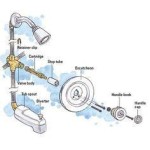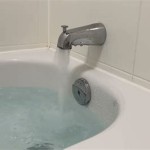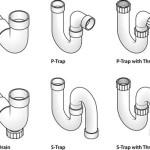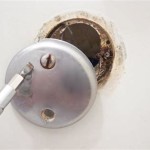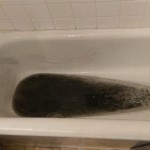Water Coming Up From Bathtub Drain: Causes, Consequences, and Solutions
The phenomenon of water backing up into a bathtub from its drain is a common household plumbing issue. This situation, while seemingly minor at first, can indicate a larger problem within the drainage system. Understanding the potential causes, the subsequent consequences, and the possible solutions is crucial for homeowners to prevent further damage and maintain a functional plumbing system. This article will explore these aspects in detail, providing a comprehensive overview of the subject.
The bathtub drain is designed to efficiently remove wastewater from the tub after use. It connects to a network of pipes that ultimately lead to the main sewer line or septic tank. When water flows freely down the drain, it signifies a properly functioning system. However, when water unexpectedly rises back up, it signals an obstruction or imbalance within the pipes, hindering the normal flow and creating a backflow.
Several factors can contribute to water coming up from the bathtub drain. These factors range from simple, easily resolvable clogs to more complex issues requiring professional intervention. Identifying the underlying cause is the first step in addressing the problem effectively. Ignoring the issue can lead to more significant plumbing problems and potentially costly repairs. Furthermore, a persistent backup can create unsanitary conditions within the home, posing a health risk to its occupants.
Common Causes of Bathtub Drain Backups
One of the most frequent causes of water backing up into the bathtub drain is a localized clog within the drainpipe itself. This clog often consists of accumulated hair, soap scum, and other debris that gradually build up over time, restricting the flow of water. In households with frequent bathtub use, this type of clog is particularly prevalent. The accumulation can occur gradually, leading to a slow drain before eventually causing a complete backup.
Another common culprit is a blockage in the main drain line. This line connects all the drains in the house to the sewer system or septic tank. A blockage in this line can affect multiple fixtures, including the bathtub, toilets, and sinks. The nature of the blockage can vary, ranging from accumulated grease and food particles to tree roots infiltrating the pipes. Tree roots, in particular, can pose a significant threat to underground plumbing systems, as they are drawn to the moisture and nutrients found within the pipes.
Furthermore, issues with the plumbing vent system can also contribute to bathtub drain backups. Plumbing vents are designed to regulate air pressure within the drainpipes, allowing water to flow smoothly. When these vents become blocked or obstructed, it can create a vacuum effect, preventing water from draining properly and potentially causing it to back up into the bathtub or other fixtures. Common causes of vent blockages include bird nests, debris, or even snow accumulation.
The type of piping material used in the plumbing system can also play a role. Older homes with cast iron pipes are more susceptible to corrosion and the build-up of rust, which can narrow the diameter of the pipes and restrict water flow. Newer PVC pipes, while more resistant to corrosion, are still susceptible to clogs from hair, soap scum, and other debris. Regardless of the piping material, regular maintenance and preventative measures are essential to maintain proper drainage.
In some cases, the issue may not be a clog or blockage at all but rather a problem with the septic system itself. A full or malfunctioning septic tank can cause wastewater to back up into the home's drainage system, including the bathtub. This is a more serious issue that requires immediate attention from a septic system professional. Signs of a septic system problem, in addition to bathtub backups, may include slow drains in other fixtures, foul odors coming from drains, and standing water in the yard near the septic tank.
Consequences of Ignoring a Bathtub Drain Backup
Ignoring a bathtub drain backup can lead to a multitude of problems, ranging from minor inconveniences to significant damage to the home and potential health hazards. The longer the issue is left unaddressed, the more severe the consequences become.
One of the immediate consequences is the inconvenience of a non-functional bathtub. This can disrupt daily routines and make it difficult to maintain personal hygiene. Furthermore, the standing water in the bathtub can be unhygienic and aesthetically unappealing.
More significantly, persistent water backups can lead to water damage to the surrounding areas. The water can seep into the walls, floors, and ceilings, causing mold growth, wood rot, and structural damage. Mold growth, in particular, can pose a serious health risk, especially for individuals with allergies or respiratory problems.
Repeated backups can also put a strain on the plumbing system, potentially leading to leaks and burst pipes. The increased pressure from the blockage can weaken the pipes over time, making them more susceptible to damage. A burst pipe can result in significant water damage and require extensive repairs.
Furthermore, the unsanitary water backing up into the bathtub can contain bacteria and other pathogens, posing a health risk to the occupants of the home. This is particularly concerning if the backup is related to a septic system issue, as the wastewater may contain harmful contaminants.
Finally, neglecting a plumbing issue can lead to costly repairs in the long run. What may start as a simple clog can eventually escalate into a major plumbing problem requiring professional intervention and potentially extensive excavation. Regular maintenance and prompt attention to any signs of drainage issues can help prevent these more significant problems from developing.
Solutions for Addressing Bathtub Drain Backups
The appropriate solution for addressing a bathtub drain backup depends on the underlying cause of the problem. Simple clogs can often be resolved with DIY methods, while more complex issues may require professional assistance.
For minor clogs caused by hair and soap scum, a plunger can often be effective. Applying a forceful plunging action can dislodge the clog and restore normal drainage. It is important to ensure that there is sufficient water in the bathtub to create a seal around the plunger cup.
A drain snake, also known as an auger, is another useful tool for clearing clogs. This flexible tool can be inserted into the drainpipe to break up or retrieve the blockage. Drain snakes are available in various lengths and sizes, depending on the severity of the clog and the diameter of the drainpipe.
Chemical drain cleaners are also available, but their use should be approached with caution. These cleaners contain harsh chemicals that can damage pipes and pose a health risk if not handled properly. It is important to follow the manufacturer's instructions carefully and wear protective gear when using chemical drain cleaners.
For more stubborn clogs or issues originating deeper within the plumbing system, it may be necessary to call a professional plumber. Plumbers have the tools and expertise to diagnose the problem accurately and implement the appropriate solution. They can use specialized equipment, such as video cameras, to inspect the pipes and identify the location and nature of the blockage.
In cases where the backup is caused by a tree root intrusion, a plumber may need to use a rooter machine to cut through the roots and clear the drainpipe. This is a more complex procedure that often requires excavation to access the affected section of pipe.
If the issue is related to the plumbing vent system, a plumber can inspect the vents for obstructions and clear them as needed. This may involve removing debris, bird nests, or other blockages that are preventing proper airflow.
Finally, if the backup is due to a septic system problem, it is essential to contact a septic system professional immediately. They can inspect the septic tank and leach field to determine the cause of the problem and recommend the appropriate course of action. This may involve pumping the tank, repairing damaged components, or even replacing the entire septic system.
Regular maintenance is key to preventing bathtub drain backups. This includes regularly cleaning the drain strainer to remove hair and debris, avoiding pouring grease or food particles down the drain, and periodically flushing the drainpipes with hot water. These simple measures can help prevent clogs from forming and maintain a properly functioning plumbing system.

Water Coming Up Through Bathtub Drain Here S Why

Why Water Might Be Coming Out Of Bathtub Drain Instead Going Down Plumbing Pipe Problems

Why Water Backs Up Into Your Tub American Home Air

Dirty Water Backing Up To Bath Tub

Why Is Water Backing Up In My Bathtub After I Flush

Flush Toilet Backing Up In Shower Or Tub Fix Fast Easy

Why Is Sewer Water Coming Up From My Tub Drain Archives Chicago Plumbing Experts

Bath Water Backing Up Into The Shower Call Our 24 7 Plumbers

My Toilet Is Backing Up In Shower Academy Air

Water Coming Up Through Bathtub Drain Here S Why
Related Posts

